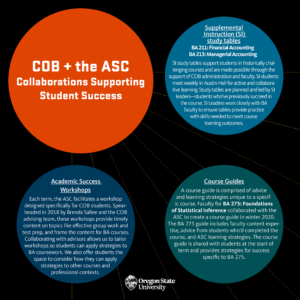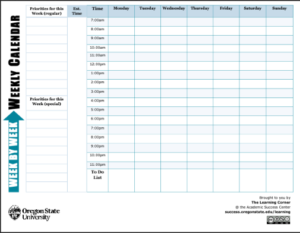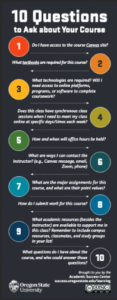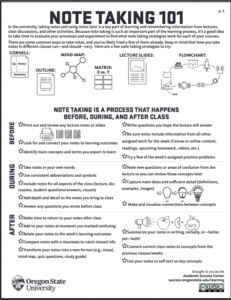Like all of OSU, the Academic Success Center (ASC) has spent the last few weeks getting programs and services up and running remotely. We’re happy to report that all ASC services are available. You can visit our website to learn how to access each one. So, what have we learned in the process? Besides the fact that we love seeing pets in meetings, of course.
Creating Meaningful Interactions
While it seemed easy from a technical standpoint to conceive of delivering services through Zoom, we wrestled with replicating elements we valued from in-person interactions. Abbey identified a challenge for Academic Coaching “to maintain the quality of conversation and relationship building that students have come to know and appreciate.” The coaching team asked, “How can we convey care, listening, and support through video/phone conversations that feel more distanced?” Before facilitating webinars, Sarah and Julia grappled with how to validate responses and engagement with a large group online. Preparing for Supplemental Instruction (SI), Chris and Angela have asked, “How can we cultivate the same sense of community in a remote environment that students experience at in-person study tables?” We’ve tried many strategies for meaningful interactions in services and are using weekly meetings and debriefs to learn more from experiences this term.
Supporting Staff
One of the biggest “lifts” in preparing for remote services was making sure student staff were prepared. While we’d previously dabbled in remote formats, there has been a lot to learn around technology. Our biggest asset in the learning process has been our student staff. Over spring break, a team of coaches helped to experiment, troubleshoot, and explore the set-up before coaching went live. Clare says they were “creative, responsive, dynamic and energized” during the process. Strategists launched the Zoom room to replace walk-in consultations. Anika noted that “a huge part of the strategist role [has always been] adapting their approach, so it makes sense that they’ve taken to this so well.”
The ASC’s training and professional development for student staff is grounded in skills like independently evaluating situations, responding to student needs, and debriefing experiences to learn from them. We’ve been able to capitalize on these foundational skills; and coaches, strategists, and SI leaders have done an amazing job thinking through service delivery in the remote environment.
We’re also acutely aware of the need to personally support student employees. Anika stresses how important is to remember that “we are all human and are experiencing this change in different ways.” This also means thinking differently about availability. Abbey has arranged “regular drop-in hours where coaches can chat about whatever is on their mind, debrief appointments, or ask questions.” We’ve noticed an important part of our job these days is the support we provide to student staff, each other, and campus partners as we navigate remote work.
Adapting to New Environments
Our professional staff’s work environments have changed as well. Marjorie now has a window, and ready access to Selena albums, leading to spikes in productivity mid-afternoon. It’s not all fresh air and Entre A Mi Mundo in terms of change though. Anika has noticed that working remotely, “you miss out on some of those spontaneous conversations that can spark new ideas.” Clare has found that “being pulled in multiple directions from work to childcare is going to require a new organizational system,” and notes that, “[she has] a lot of appreciation for student parents right now.”
These changes have not been easy on any of us, and our team is mindful of the challenges facing the OSU community as we engage remotely. At the ASC, we’re doing our best to make navigating this term a little smoother and hopefully a little less isolating. To that end, we’ve found value in communicating frequently, being flexible, showing up as human beings, and, above all, demonstrating compassion for ourselves and others.






